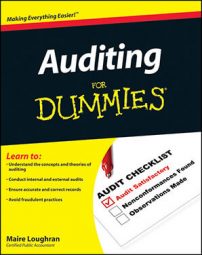During your audit, you need to test management financial statement assertions. When you test cash disbursements during an audit, your first job is to figure out how your audit client pays its invoices. For cash disbursement transactions you need to test five assertions: occurrence, completeness, authorization, accuracy, and cutoff.
Occurrence: Occurrence tests whether the payment transactions actually took place. Here’s what you’re looking for:
Did the company record the payment in the books but never cut the check?
Did the company prepare the check but never mail it to the vendor?
To test this assertion, select a sample of the client’s vendor statements and vouch them back to the vendor’s accounts payable.
Completeness: Completeness evaluates the management assertion opposite of occurrence. In the purchasing and payable process, understatement is your highest risk.
Discovering this problem is kind of a no-brainer. Say the client is on a calendar year-end. You take the December bank statement and trace a sampling of checks or electronic funds transfers (EFTs) clearing on the bank statement to the books. (Normally, auditors use transactions over a certain dollar amount to select a sample.) Next, see whether any payments reflected on the January bank statements have December issuing dates. If so, trace those back to the books too.
Authorization: This step addresses whether your client’s management and staff follow proper internal controls or other company authorization procedures when handling revenue transactions. Cash disbursements should be approved by the appropriate level of management. To test this assertion, select a sample of payments and check that all payments have proper authorization.
A further step is to vouch the cash disbursement back to the source document. In larger companies, an employee in the originating department may authorize an invoice for payment. In that case, check that different types of expenses are being approved by individuals who would be familiar with the type of expense. For example, approval for an advertising expense should come from an employee in marketing, not an employee in manufacturing.
Accuracy: Testing accuracy addresses whether transactions are free from error. For cash disbursements transactions, three potential issues exist. If you find errors in any of the three, the client can easily correct them:
Dollar amount: Did the company record the payment for the correct dollar amount? If not, have the client edit the payment by entering the correct amount.
Client posting: Was the correct vendor account reduced? If the payment posts to the wrong vendor, have the client edit the affected vendor ledgers.
Account posting: Was the payment taken to the correct financial statement account? Once again, having the client take the payment to the correct account is a quick fix.
Cutoff: Clients may try to move accounting transactions from one year to another to show more positive results. Your job as an auditor is to have reasonable assurance the company records payables and payments when they’re incurred.
You test for cutoff by selecting a sample of receiving reports and making sure the client records the associated vendor invoice. You can also select a sample of vendor invoices and trace them back to the client’s books. Make sure the invoice date matches the date the invoice is recorded.

